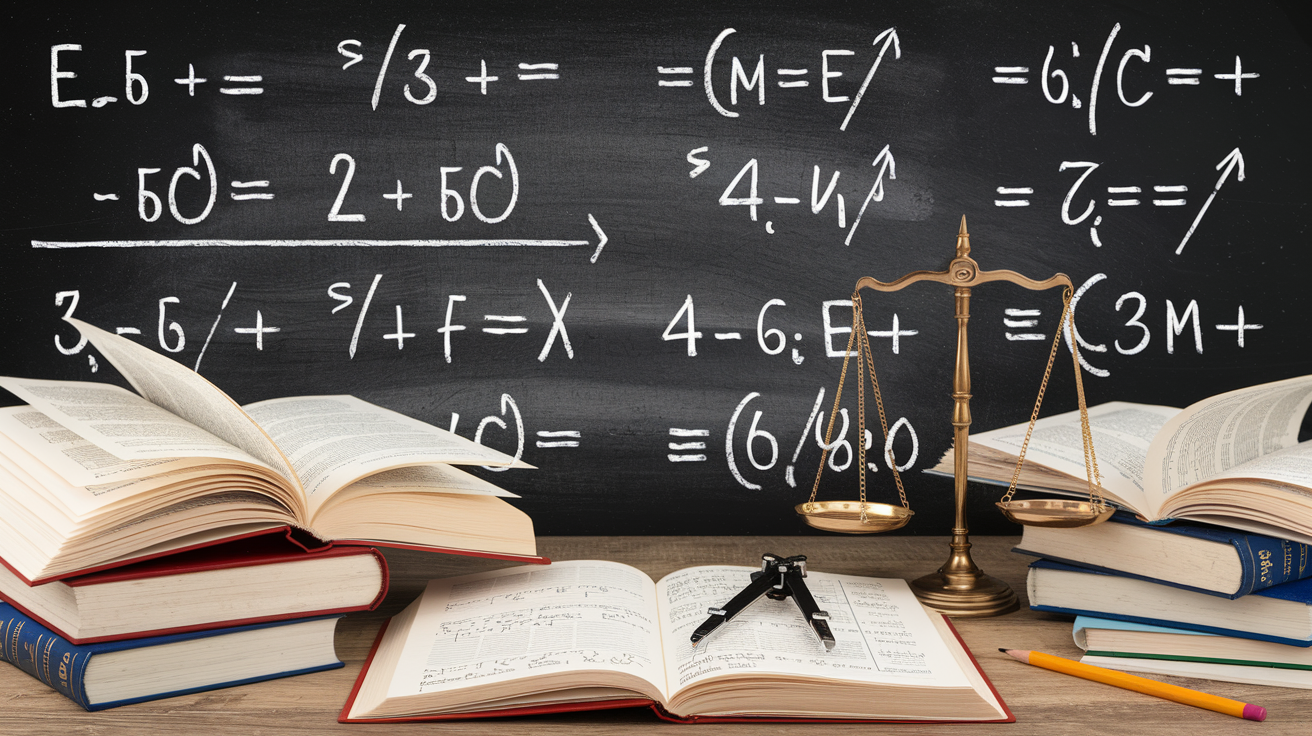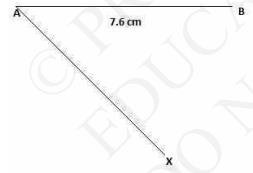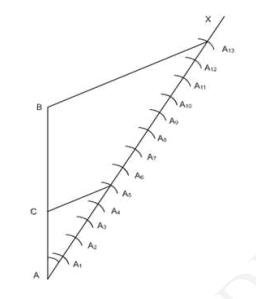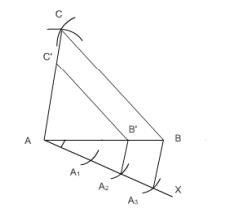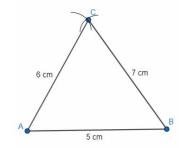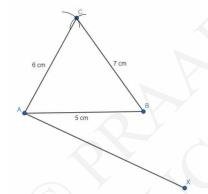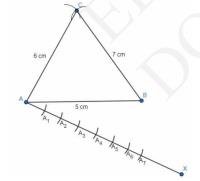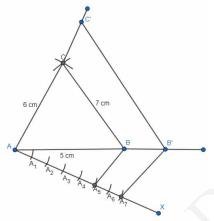4. Construct an isosceles triangle whose base is 8 cm and altitude 4 cm and then another triangle whose sides are \( 1 \frac{1}{2} \) times the corresponding sides of the isosceles triangle.
Answer
Steps of construction:i. Now in order to make a triangle, draw a line segment \( \mathrm{AB}=8 \mathrm{~cm} \).

ii. Draw two arcs intersecting at 4 cm distance from points A and B; on either side of AB.
Join these arcs to get perpendicular bisector CD of AB. (Since, altitude is the perpendicular bisector of base of isosceles triangle).
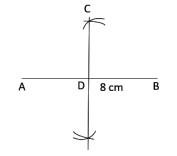
iii. Join points \( A \) and \( B \) to \( C \) in order to get the triangle \( A B C \).
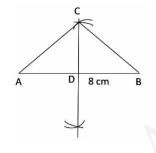
iv. Now, draw a ray AX which is at an acute angle from point A .
As \( 1 \frac{1}{2}=\frac{3}{2} \)
And 3 is greater between 3 and 2, So Plot 3 points on \(AX\) such that: \( \mathrm{AA}_{1}=\mathrm{A}_{1} \mathrm{~A}_{2}=\mathrm{A}_{2} \mathrm{~A}_{3} \).
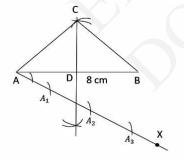
v. As 2 is smaller between 2 and 3 . Join \( \mathrm{A}_{2} \) to point B . Draw a line from \( \mathrm{A}_{3} \) which is parallel to \( \mathrm{A}_{2} \mathrm{~B} \) meeting the extension of \( A B \) at \( B^{\prime} \).
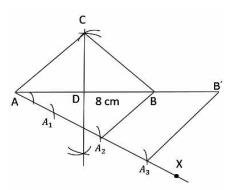
vi. Draw \( \mathrm{B}^{\prime} \mathrm{C}^{\prime} \| \mathrm{BC} \). Then, draw \( \mathrm{A}^{\prime} \mathrm{C}^{\prime} \| \mathrm{AC} \).
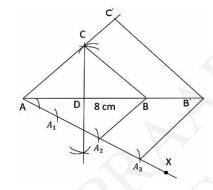
Triangle \( \mathrm{AB}^{\prime} \mathrm{C}^{\prime} \) is the required triangle.
Justification:
We need to prove,
\( \frac{A C \prime}{A C}=\frac{A B \prime}{A B}=\frac{C \prime B \prime}{C B}=\frac{3}{2} \)
By construction \( \frac{A B^{\prime}}{A B}=\frac{A A_{3}}{A A_{2}}=\frac{3}{2} \) \(\quad\dots.\)(1)
\(s C'B'\| CB\)
They will maker equal angles with line \( \mathrm{AB} \angle \mathrm{ACB}=\angle \mathrm{AC}^{\prime} \mathrm{B}^{\prime} \)\(\quad \dots.\) (corresponding angles)
In \( \triangle \mathrm{ACB} \) and \( \triangle \mathrm{AC}^{\prime} \mathrm{B}^{\prime} \)
\( \angle \mathrm{A}=\angle \mathrm{A} \) (common) \( \angle \mathrm{ACB}=\angle \mathrm{AC} \mathrm{B}^{\prime} \) (corresponding angles)
So \( \triangle \mathrm{ACB} \sim \triangle \mathrm{AC}^{\prime} \mathrm{B}^{\prime} \)
As corresponding sides of similar triangles are in ratio, Hence, \( \frac{A C \prime}{A C}= \) \( \frac{A C^{\prime}}{A C}=\frac{A B \prime}{A B}=\frac{C \prime B \prime}{C B}=\frac{3}{2} \)
CBSE Solutions for Class 10 Maths Chapter 11: Constructions || CBSE Class 10 Maths Chapter 11 Constructions solutions Ex 11.1
Download the Math Ninja App Now
5. Draw a triangle \( A B C \) with side \( B C=6 \mathrm{~cm}, A B=5 \mathrm{~cm} \) and \( \angle A B C=60^{\circ} \). Then construct a triangle whose sides are \( \frac{3}{4} \) of the corresponding sides of the triangle ABC .
Answer
Given in \( \Delta \mathrm{ABC} \),Length of side \( \mathrm{BC}=6 \mathrm{~cm} \).
Length of side \( \mathrm{AB}=5 \mathrm{~cm} \).
\( \angle \mathrm{ABC}=60^{\circ} \).
Steps of Construction:
1. Draw a line segment BC of length 6 cm .

2. With B as center, draw a line which makes an angle of \( 60^{\circ} \) with BC.
Construction of \( 60^{\circ} \) angle at B:
a. With B as centre and with some convenient radius draw an arc which cuts the line BC at
D.

b. With D as radius and with same radius (in step a), draw another arc which cuts the previous arc at E.
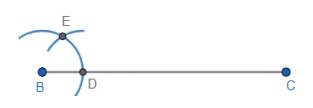
c. Join BE. The line BE makes an angle \( 60^{\circ} \) with BC.
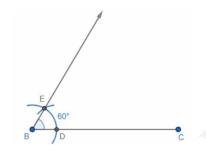
3. Again with \( B \) as centre and with radius of 5 cm , draw an arc which intersects the line BE at point A .
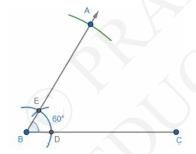
4. Join AC. This is the required triangle.
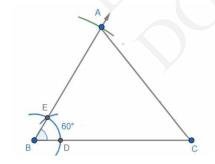
5. Now, from B , draw a ray BX which makes an acute angle on the opposite side of the vertex \( A \).
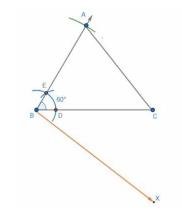
6. With \( B \) as center, mark four points \( B_{1}, B_{2}, B_{3} \) and \( B_{4} \) on \( B X \) such that they are equidistant. i.e. \( \mathrm{BB}_{1}=\mathrm{B}_{1} \mathrm{~B}_{2}=\mathrm{B}_{2} \mathrm{~B}_{3}=\mathrm{B}_{3} \mathrm{~B}_{4} \).
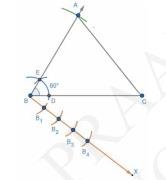
7. Join \( B_{4} C \) and then draw a line from \( B_{3} \) parallel to \( B_{4} C \) which meets the line BC at P .
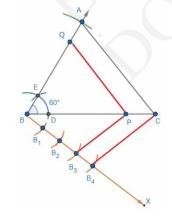
8. From \( P \), draw a line parallel to \( A C \) and meets the line \( A B \) at \( Q \). Thus \( \triangle \mathrm{BPQ} \) is the required triangle.
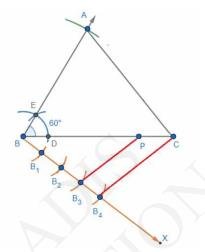
CBSE Solutions for Class 10 Maths Chapter 11: Constructions || CBSE Class 10 Maths Chapter 11 Constructions solutions Ex 11.1
Download the Math Ninja App Now6. Draw a triangle \(ABC\) with side \( \mathrm{BC}=7 \mathrm{~cm}, \angle \mathrm{B}=45^{\circ}, \angle \mathrm{A}= \) \( 105^{\circ} \). Then, construct a triangle whose sides are \( \frac{4}{3} \) times the corresponding sides of \( \triangle \mathrm{ABC} \).
Answer
Steps of construction:1. Draw a line segment \( \mathrm{BC}=7 \mathrm{~cm} \).

2. Draw \( \angle \mathrm{ABC}=45^{\circ} \) and \( \angle \mathrm{ACB}=30^{\circ} \) i.e. \( \angle \mathrm{BAC}=105^{\circ} \).
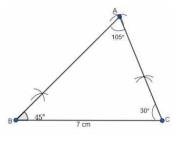
We obtain \( \triangle \mathrm{ABC} \).
3. Draw a ray \(BX\) making an acute angle with BC. Mark four points \( \mathrm{B}_{1}, \mathrm{~B}_{2}, \mathrm{~B}_{3}, \mathrm{~B}_{4} \) at equal distances.
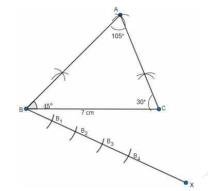
4. Through \( \mathrm{B}_{3} \) draw \( \mathrm{B}_{3} \mathrm{C} \) and through \( \mathrm{B}_{4} \) draw \( \mathrm{B}_{4} \mathrm{C}_{1} \) parallel to \( \mathrm{B}_{3} \mathrm{C} \). Then draw \( \mathrm{A}_{1} \mathrm{C}_{1} \) parallel to AC.
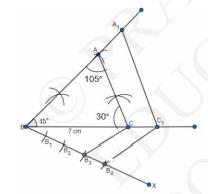
\( \therefore \mathrm{A}_{1} \mathrm{BC}_{1} \) is the required triangle.
CBSE Solutions for Class 10 Maths Chapter 11: Constructions || CBSE Class 10 Maths Chapter 11 Constructions solutions Ex 11.1
Download the Math Ninja App Now7. Draw a right triangle in which the sides (other than hypotenuse) are of lengths 4 cm and 3 cm . Then construct another triangle whose sides are \( \frac{5}{3} \) times the corresponding sides of the given triangle.
Answer
Steps of construction:1. Now in order to make a triangle, draw a line segment \( \mathrm{AB}=3 \) cm .

2. Make a right angle at point A and draw \( \mathrm{AC}=4 \mathrm{~cm} \) from this point.
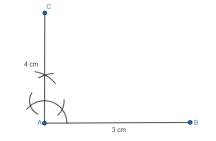
3. Join points \( A \) and \( B \) to get the right triangle \( A B C \).
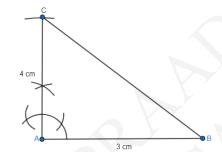
4. Now, Dividing the base, draw a ray \(AX\) such at it forms an acute angle from \( A B \).
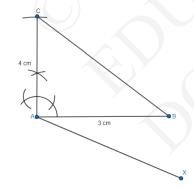
5. Then, plot 5 points on \( A X \) such that: \(\mathrm{AG}=\mathrm{GH}=\mathrm{HI}=\mathrm{IJ}=\mathrm{JK} .\)
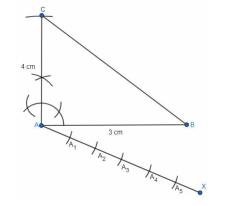
6. Join I to point line \( A B \) and Draw a line from \(K\) which is parallel to \(IB\) such that it meets \(AB\) at point \(M\) .
7. Draw \( \mathrm{MN} \| \mathrm{CB} \).
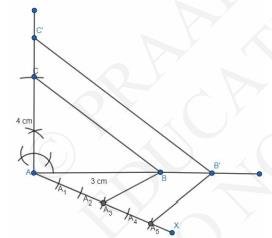
This is the required construction, thus forming \(AMN\) which have all the sides \( \frac{ 5 }{ 3 } \) times the sides of \(ABC\)
Triangle \(AMN\) is the required triangle.
CBSE Solutions for Class 10 Maths Chapter 11: Constructions || CBSE Class 10 Maths Chapter 11 Constructions solutions Ex 11.1
Download the Math Ninja App NowCentral Board of Secondary Education Official Site
Class 10 : NCERT Solutions for Class 10 Maths Chapter 1 Exercise 1.1
Class 10 : NCERT Solutions for Class 10 Maths Chapter 1 Exercise 1.2
Class 10 : NCERT Solutions for Class 10 Maths Chapter 1 Exercise 1.3
Class 10 : CBSE Class 10 Maths Chapter 2 Polynomials Ex 2.1
Class 10 : CBSE Class 10 Maths Chapter 2 Polynomials Ex 2.2
Class 10 : CBSE Class 10 Maths Chapter 2 Polynomials Ex 2.4
Class 10 : CBSE Class 10 Maths Chapter 3 Pair of Linear Equations in Two Variables Ex 3.1
Class 10 : CBSE Class 10 Maths Chapter 3 Pair of Linear Equations in Two Variables solutions Ex 3.2
Class 10 : CBSE Class 10 Maths Chapter 3 Pair of Linear Equations in Two Variables solutions Ex 3.3
Class 10 : CBSE Class 10 Maths Chapter 3 Pair of Linear Equations in Two Variables solutions Ex 3.4
Class 10 : CBSE Class 10 Maths Chapter 3 Pair of Linear Equations in Two Variables solutions Ex 3.5
Class 10 : CBSE Class 10 Maths Chapter 3 Pair of Linear Equations in Two Variables solutions Ex 3.6
Class 10 : CBSE Class 10 Maths Chapter 4 Quadratic Equations Ex 4.1
Class 10 : CBSE Class 10 Maths Chapter 4 Quadratic Equations Ex 4.2
Class 10 : CBSE Class 10 Maths Chapter 4 Quadratic Equations Ex 4.3
Class 10 : CBSE Class 10 Maths Chapter 5 Arithmetic Progressions Ex 5.1
Class 10 : CBSE Class 10 Maths Chapter 5 Arithmetic Progressions Ex 5.2
Class 10 : CBSE Class 10 Maths Chapter 5 Arithmetic Progressions Ex 5.3
Class 10 : CBSE Class 10 Maths Chapter 6 Triangle Ex 6.1
Class 10 : CBSE Class 10 Maths Chapter 6 Triangle Ex 6.2
Class 10 : CBSE Class 10 Maths Chapter 6 Triangle Ex 6.3
Class 10 : CBSE Class 10 Maths Chapter 6 Triangle Ex 6.4
Class 10 : CBSE Class 10 Maths Chapter 6 Triangle Ex 6.5
Class 10 : CBSE Class 10 Maths Chapter 6 Triangle Ex 6.6
Class 10 : CBSE Class 10 Maths Chapter 7 Coordinate Geometry Ex 7.1
Class 10 : CBSE Class 10 Maths Chapter 7 Coordinate Geometry Ex 7.2
Class 10 : CBSE Class 10 Maths Chapter 7 Coordinate Geometry Ex 7.3
Class 10 : CBSE Class 10 Maths Chapter 7 Coordinate Geometry Ex 7.4
Class 10 : NCERT Solutions for Class 10 Maths Chapter 8 Exercise 8.1
Class 10 : NCERT Solutions for Class 10 Maths Chapter 8 Exercise 8.2
Class 10 : NCERT Solutions for Class 10 Maths Chapter 8 Exercise 8.3
Class 10 : NCERT Solutions for Class 10 Maths Chapter 8 Exercise 8.4
Class 10 : CBSE Class 10 Maths Chapter 10 Circles solutions Ex 10.2
Class 10 : CBSE Class 10 Maths Chapter 13 Surface Areas and Volumes solutions Ex 13.2
